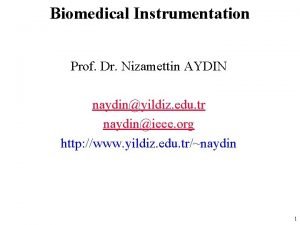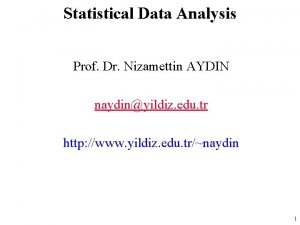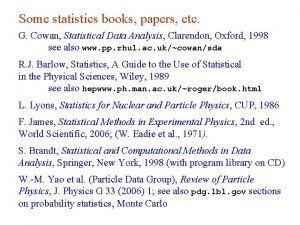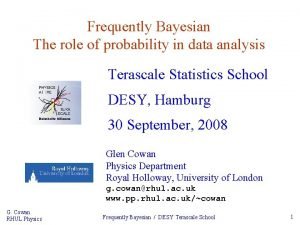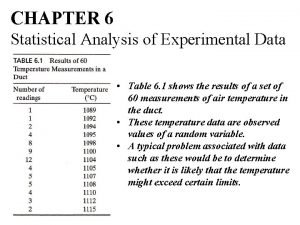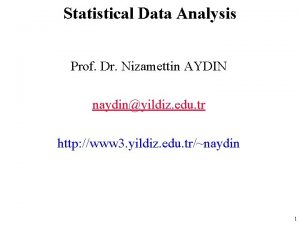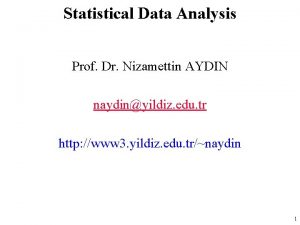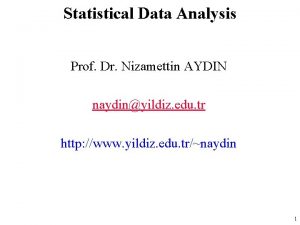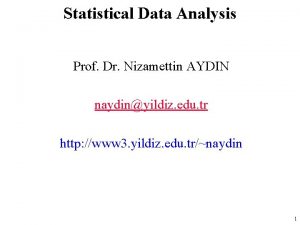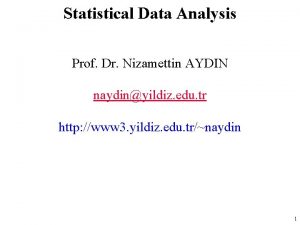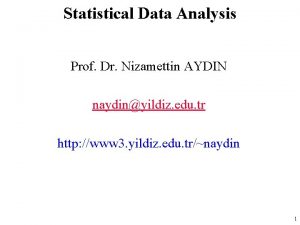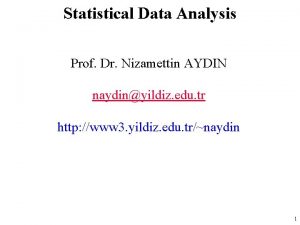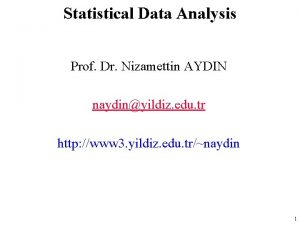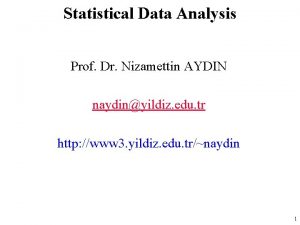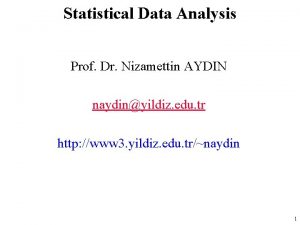Statistical Data Analysis Prof Dr Nizamettin AYDIN naydinyildiz












- Slides: 12

Statistical Data Analysis Prof. Dr. Nizamettin AYDIN naydin@yildiz. edu. tr http: //www 3. yildiz. edu. tr/~naydin 1

Analysis of Variance (ANOVA) 2

ANOVA • 3

ANOVA • 4

ANOVA • 5

ANOVA For the one-way ANOVA, the F-statistic has F(df 1 = k − 1, df 2 = n − k) distribution under the null hypothesis (i. e. , assuming that the null hypothesis is true). The F-distribution, which is a continuous probability distribution, is very important for hypothesis testing. It is specified by two parameters, df 1 and df 2, and is denoted as F(df 1, df 2). We refer to df 1 and df 2 as the numerator degrees of freedom and denominator degrees of freedom, respectively. Both parameters must be positive. 6

ANOVA The following figure shows the pdf of F-distribution for different values of df 1 and df 2. 7

Example • As an example, we analyze the Cushings data set, which is available from the MASS package. – Cushing’s syndrome is a hormone disorder associated with high level of cortisol secreted by the adrenal gland. • The Type variable in the data set shows the underlying type of syndrome, which can be one of four categories: – – adenoma (a), bilateral hyperplasia (b), carcinoma (c), unknown (u). 8

Example • Objective is to find whether the four groups are different with respect to urinary excretion rate of Tetrahydrocortisone. • We denote by Y the urinary excretion rate of Tetrahydrocortisone and by X the Type variable, – where X = 1 for Type = a, X = 2 for Type = b, X = 3 for Type = c, and X = 4 for Type = u. • Then, our objective could be defined as investigating whether the mean of the response variable Y differs for different values (levels) of the factor X. 9

Example • 10

Example • SSB = 893. 5 and SSW = 2123. 6. • The observed value of F-statistic is f = 3. 2 given under the column labeled F value. • The resulting p-value is then 0. 04. • Therefore, we can reject H 0 at 0. 05 significance level (but not at 0. 01) and conclude that the differences among group means for urinary excretion rate of Tetrahydrocortisone are statistically significant (at 0. 05 level). 11

Example • For plotting the F(3, 23) distribution using R-Commander, click Distribution → Continuous distributions→ F distribution Plot F distribution. • Set the Numerator degrees of freedom to 3 and the Denominator degrees of freedom to 23. • The density plot of F(3, 23)-distribution. • This is the distribution of F-statistic for the Cushings data assuming that the null hypothesis is true. • The observed value of the test statistic is f = 3. 2, and the corresponding p-value is shown as the shaded area above 3. 2 12
 Prof. dr. nizamettin aydin
Prof. dr. nizamettin aydin Prof. dr. nizamettin aydin
Prof. dr. nizamettin aydin Prof. dr. nizamettin aydin
Prof. dr. nizamettin aydin Prof. dr. nizamettin aydin
Prof. dr. nizamettin aydin Nizamettin aydin
Nizamettin aydin Package diagram
Package diagram Mega giga tera peta
Mega giga tera peta Preserving statistical validity in adaptive data analysis
Preserving statistical validity in adaptive data analysis Cowan statistical data analysis
Cowan statistical data analysis State bayes theorem
State bayes theorem Statistical analysis of experimental data
Statistical analysis of experimental data Sinan aydın mali müşavir
Sinan aydın mali müşavir Aydın kendirci
Aydın kendirci



